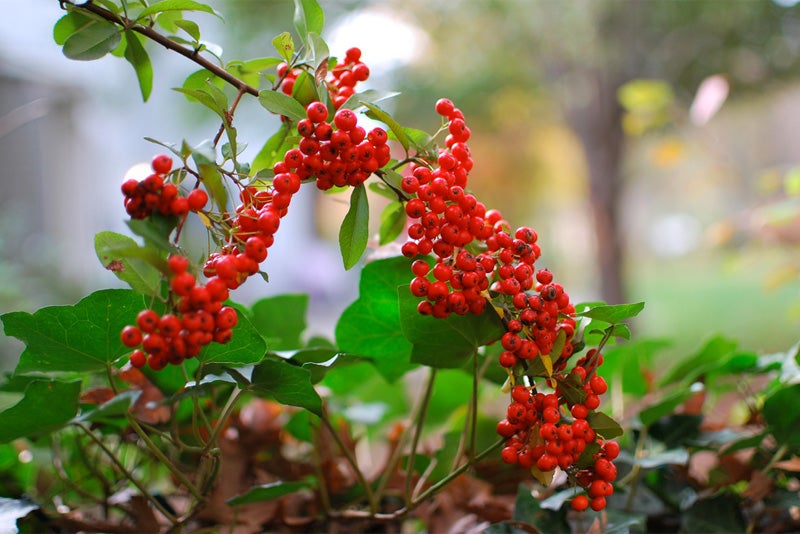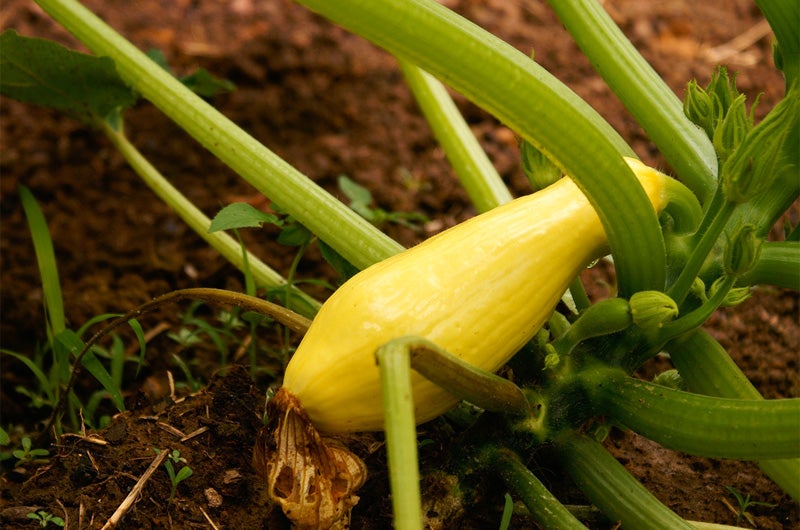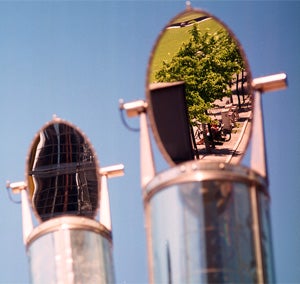Want bright, red berries during winter? We’ll show you how
ListenMike explains the process of growing apple trees from seed, why native bees are so important, the dangers of GMO’s, using a heliostat to increase sun in a shady spot, the best way to care for jade and how to get more red berries out of your firethorn. Plus, Mike speaks with special guest David Salman about golden summer squash.
Question of the Week:
“How and when should I prune my pyracanthus to get more red berries? They get good sun but I see that other peoples’ plants have more berries. I have them espaliered with lattice work. They get sun from early morning to about 3 in the afternoon. They are not mulched nor fed. I did prune off the back branches so I could espalier them. They are not crowded; it will take a few years for that to happen as they are not old. I planted one about 3 years ago, but had to move it to a sunnier spot; that’s when I built the trellises. It has done well, is now about four feet tall and has very pretty red berries. Two months ago I bought three more. They are about 2 feet tall and are doing well. I’m away all summer, so I have no interest in the flowers. But I am here all winter, and you are correct, I want lots of berries. I once saw ‘pyros’ that had berries everywhere on a garden tour; a whole wall of them. Unfortunately I did not ask the owner how he got them so full.”
— Adrian in Swarthmore, PA
How to get more berries out of your firethorn »
Highlights from show for January 11, 2014:
Growing an apple tree from seeds
Laura from Yellow Springs, Ohio started a gardening experiment with her granddaughter last winter: They planted the seeds from an apple. Laura’s seeds sprouted and her tree thrived outside during the summer. But when she took the tree inside for the winter it started to wither. Mike explains, “Apples need a chilling period. Apples, peaches, pears, all of these kinds of stone fruits and seed fruits, they have a certain requirement to be outside in cold temperatures for x-hundred number of hours, temperatures below forty-five degrees … I’ve never heard of an apple being successfully grown indoors.” Mike encourages Laura to try again and get some seeds started for a new apple tree.
Golden summer squash with special guest David Salman, Chief Horticulturalist at High Country Gardens
Jim from Placerville, California cultivates a garden in the foothills of the Sierra Nevada Mountains. Jim is struggling to grow summer squash in the acidic clay soil despite his efforts to fertilize and stabilize the pH. When Jim describes how his squash blossoms either wither on the vine or turn brown just as they begin to produce fruit, Mike says “If they didn’t ever make fruit then we would worry about your pollinators, but this is a condition that does effect summer squash: It’s actually a true disease and its in your soil.” To prevent squash blossom end rot Mike advises Jim to plant his squash in a different area of the garden, continue to improve the soil with pearlite, and plant fewer plants per square foot. Mike also thinks the altitude of about 3000 ft is affecting Jim’s garden so calls on David Salman, Chief Horticulturalist at High Country Gardens for expert advice. David reminds Jim that “in a heavier clay, everyday watering might get a little soggy and then that might enhance the bacterial component of this end rot.”
All kinds of bees
Patti from Kennett Square, Pennsylvania called to follow up on a previous call about shade blooming plants that attract bees and butterflies. Patti has a thriving euonymus shrub that attracts a wide array of bees and other insects when it blooms. Mike thanks Patti for adding this plant to the list of shade bloomers and explains that native bees look nothing like the iconic, fuzzy, striped honey bee. “Thank you for recognizing that these creatures that visit your plants are bees … A lot of times these native bees are really wild looking and we would never consider that they’re bees, but they’re absolutely essential for our plant health … And with honey bee colonies being devastated by disease the way they are our native bees become more important every year.”
Caring for jade plants
Brian from Kutztown, Pennsylvania jade plant 10 years ago that has long been thriving. Lately, however, he’s noticing that some of the jade “branches” are going soft and almost rotten. Mike explains: “There’s a couple of things that could go wrong. If the plant doesn’t get enough sun in the summertime when it’s outside, it can get leggy and misshapen. If it’s underwatered, it can start to get brown dry spots on what we’ll call the leaves. If it gets overwatered, similar things can happen. But believe it or not, these jade plants that, you know, most people would put them in the bullet-proof range, but they’re really not. They require some care.” Mike continues to explain that jade plants are prone to a specific disease that does cause the symptoms Brian is seeing. The biggest cause of this disease is lack of ventilation or airflow. Mike advises that Brian remove any diseased parts of the plant, repot it with pearlite mixed into the soil and be careful to place the plants in a well-ventilated area.
-

Photo by Flickr user beautifulcataya
Will a heliostat bring sunlight to a shady garden?
Ben from Yardley, Pennsylvania is renovating his kitchen and creating a kitchen garden with four raised beds in his yard. But Ben’s yard is shady and he’s concerned that his plants will be deprived of sunlight. Ben asks Mike if a heliostat – a device that reflects and redirects sunlight – might help his plants. Although Mike hasn’t heard of other home gardeners using heliostats, he encourages Ben to give it a try. “It’s very important that you follow my old-school caveat which is: if you can’t give your plants enough sun, make sure you give them everything else. Make sure those beds are nice and raised. Make sure their soil is light and fluffy and you never step in it. Don’t water overhead. Don’t overwater. Don’t overfeed until you see what’s going on. And then the sign of too little light is leggy plants – plants that are tall and spindly.”
“It’s very important that you follow my old-school caveat which is: if you can’t give your plants enough sun, make sure you give them everything else … And then the sign of too little light is leggy plants – plants that are tall and spindly.”
Mike McGrath
— This week’s post was written by Marissa Nicosia, You Bet Your Garden intern
WHYY is your source for fact-based, in-depth journalism and information. As a nonprofit organization, we rely on financial support from readers like you. Please give today.




